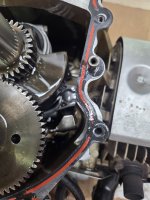Take a look at this video for a engine model same as yours.
This guy is making the static governor adjustment. (opposite of the recommended procedure)
422707-1275-1
Setting governor for Briggs L Head opposed twin 18hp
Keep in mind that the governor shaft only moves approx 90 degrees or less full travel.
After making a static governor adjust if the engine is overspeeding I do as this guy and adjust the governor just the opposite.
I've seen some Briggs engines that the governor shaft had to be adjusted completely backwards of what the service manual indicates to keep from overspeeding and to get lower rpms per the throttle.
With the engine not running and the throttle set to idle manually turning the governor shaft through it complete range should move the carb throttle shaft towards idle. If not the springs and or linkages on the throttle plate is binding or wrong.
This guy is making the static governor adjustment. (opposite of the recommended procedure)
422707-1275-1
Setting governor for Briggs L Head opposed twin 18hp
Keep in mind that the governor shaft only moves approx 90 degrees or less full travel.
After making a static governor adjust if the engine is overspeeding I do as this guy and adjust the governor just the opposite.
I've seen some Briggs engines that the governor shaft had to be adjusted completely backwards of what the service manual indicates to keep from overspeeding and to get lower rpms per the throttle.
With the engine not running and the throttle set to idle manually turning the governor shaft through it complete range should move the carb throttle shaft towards idle. If not the springs and or linkages on the throttle plate is binding or wrong.

